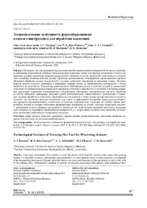| dc.contributor.author | Козерук, А. С. | |
| dc.contributor.author | Диас Гонсалес, Р. О. | |
| dc.contributor.author | Сухоцкий, А. А. | |
| dc.contributor.author | Филонова, М. И. | |
| dc.contributor.author | Кузнечик, В. О. | |
| dc.coverage.spatial | Минск | ru |
| dc.date.accessioned | 2020-08-04T07:18:51Z | |
| dc.date.available | 2020-08-04T07:18:51Z | |
| dc.date.issued | 2020 | |
| dc.identifier.citation | Технологические особенности формообразования плоского инструмента для обработки аксиконов = Technological Features of Forming Flat Tool for Processing Axicons / А. С. Козерук [и др.] // Наука и техника. – 2020. – № 4. – С. 297-304. | ru |
| dc.identifier.uri | https://rep.bntu.by/handle/data/77403 | |
| dc.description.abstract | Обосновано, что для управления процессом формообразования плоских поверхностей по методу свободного притирания целесообразно выбирать такие наладочные параметры станка, как диаметр инструмента и частота его вращения, величина амплитуды возвратно-вращательного движения детали по инструменту (или наоборот) и частота этого движения, величина рабочего усилия. Проведено математическое моделирование закономерностей процесса абразивной обработки плоских поверхностей в условиях свободного притирания на рычажных станках. Получена формула расчета скорости скольжения в выбранных опорных точках на обрабатываемой поверхности с учетом давления в их окрестности. Определены закономерности срабатывания детали, в качестве которой в предлагаемой технологии получения аксиконов используется правильная пластина в зависимости от сочетания и величины выбранных наладочных параметров технологического оборудования. Обоснована самоорганизация процесса обработки по методу свободного притирания. Выполнен расчет чувствительности кинематического срабатывания к изменению режимов обработки и определена эффективность этих режимов с точки зрения производительности процесса. Отмечено, что увеличение диаметра инструмента, как одного из эффективных наладочных параметров при управлении процессом формообразования, осуществить на практике затруднительно, поскольку это требует замены инструментов, каждый из которых необходимо предварительно настраивать по особой, довольно трудоемкой методике. С увеличением частоты вращения инструмента и амплитуды его колебательных движений происходит усиленный съем материала на периферии обрабатываемой поверхности, а с возрастанием колебательных движений, наоборот, более интенсивно срабатывается центральная зона детали. | ru |
| dc.language.iso | ru | ru |
| dc.publisher | БНТУ | ru |
| dc.title | Технологические особенности формообразования плоского инструмента для обработки аксиконов | ru |
| dc.title.alternative | Technological Features of Forming Flat Tool for Processing Axicons | ru |
| dc.type | Article | ru |
| dc.identifier.doi | 10.21122/2227-1031-2020-19-4-297-304 | |
| local.description.annotation | It has been substantiated that in order to control the process of forming flat surfaces while using a free grinding method it is advisable to choose such machine setup parameters as a tool diameter and its rotation frequency, an amplitude of the reciprocating movement of the part along the tool (or vice versa) and frequency of this movement, as well as the value of the working force. Mathematical modeling of patterns for abrasive processing of flat surfaces in the conditions of free grinding on lever machines has been carried out in the paper. A formula has been obtained for calculating a sliding speed at selected reference points on the surface to be treated while taking into account the pressure in their vicinity. Patterns of the part operation have been determined, for which a correct plate is used in the proposed axicon production technology with due account of the combination and size of the selected setup parameters for processing equipment. Self-organization of the processing process has been substantiated while using a free grinding method. Sensitivity of a kinematic response to a change in processing modes and efficiency of these modes in terms of process performance have been determined in the paper. It has been noted that an increase in a tool diameter, as one of the effective adjustment parameters for controlling the shaping process, is difficult to implement in practice, since this requires replacement of tools, each of which must be preconfigured while using a special rather time-consuming technique. The paper reveals that with an increase in the tool rotation frequency and an amplitude of its oscillatory movements, there is an increased removal of material on the periphery of the surface being machined, and with an increase in vibrational movements, on the contrary, the central zone of the part is more intensively activated. | ru |

